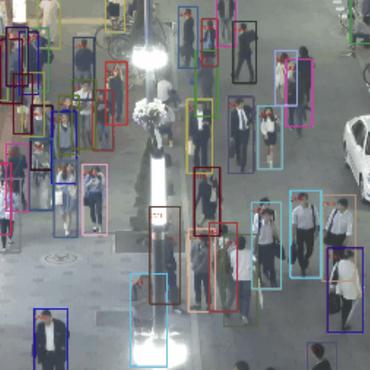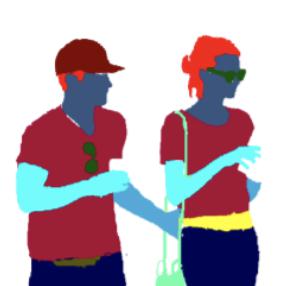Search Results for author: Dawei Du
Found 27 papers, 13 papers with code
Open Set Action Recognition via Multi-Label Evidential Learning
no code implementations • CVPR 2023 • Chen Zhao, Dawei Du, Anthony Hoogs, Christopher Funk
Existing methods for open-set action recognition focus on novelty detection that assumes video clips show a single action, which is unrealistic in the real world.
Human Activity Recognition in an Open World
no code implementations • 23 Dec 2022 • Derek S. Prijatelj, Samuel Grieggs, Jin Huang, Dawei Du, Ameya Shringi, Christopher Funk, Adam Kaufman, Eric Robertson, Walter J. Scheirer
Managing novelty in perception-based human activity recognition (HAR) is critical in realistic settings to improve task performance over time and ensure solution generalization outside of prior seen samples.
Reconstructing Humpty Dumpty: Multi-feature Graph Autoencoder for Open Set Action Recognition
no code implementations • 12 Dec 2022 • Dawei Du, Ameya Shringi, Anthony Hoogs, Christopher Funk
Our approach uses the reconstruction error to determine the novelty of the video since unknown classes are harder to put back together and thus have a higher reconstruction error than videos from known classes.
MEVID: Multi-view Extended Videos with Identities for Video Person Re-Identification
1 code implementation • 9 Nov 2022 • Daniel Davila, Dawei Du, Bryon Lewis, Christopher Funk, Joseph Van Pelt, Roderick Collins, Kellie Corona, Matt Brown, Scott McCloskey, Anthony Hoogs, Brian Clipp
In this paper, we present the Multi-view Extended Videos with Identities (MEVID) dataset for large-scale, video person re-identification (ReID) in the wild.
Unbiased Multi-Modality Guidance for Image Inpainting
1 code implementation • 25 Aug 2022 • Yongsheng Yu, Dawei Du, Libo Zhang, Tiejian Luo
Image inpainting is an ill-posed problem to recover missing or damaged image content based on incomplete images with masks.
Multi-Granularity Alignment Domain Adaptation for Object Detection
1 code implementation • CVPR 2022 • Wenzhang Zhou, Dawei Du, Libo Zhang, Tiejian Luo, Yanjun Wu
Domain adaptive object detection is challenging due to distinctive data distribution between source domain and target domain.
Cascade Transformers for End-to-End Person Search
1 code implementation • CVPR 2022 • Rui Yu, Dawei Du, Rodney LaLonde, Daniel Davila, Christopher Funk, Anthony Hoogs, Brian Clipp
In this paper, we propose the Cascade Occluded Attention Transformer (COAT) for end-to-end person search.
VisDrone-CC2020: The Vision Meets Drone Crowd Counting Challenge Results
1 code implementation • 19 Jul 2021 • Dawei Du, Longyin Wen, Pengfei Zhu, Heng Fan, QinGhua Hu, Haibin Ling, Mubarak Shah, Junwen Pan, Ali Al-Ali, Amr Mohamed, Bakour Imene, Bin Dong, Binyu Zhang, Bouchali Hadia Nesma, Chenfeng Xu, Chenzhen Duan, Ciro Castiello, Corrado Mencar, Dingkang Liang, Florian Krüger, Gennaro Vessio, Giovanna Castellano, Jieru Wang, Junyu Gao, Khalid Abualsaud, Laihui Ding, Lei Zhao, Marco Cianciotta, Muhammad Saqib, Noor Almaadeed, Omar Elharrouss, Pei Lyu, Qi Wang, Shidong Liu, Shuang Qiu, Siyang Pan, Somaya Al-Maadeed, Sultan Daud Khan, Tamer Khattab, Tao Han, Thomas Golda, Wei Xu, Xiang Bai, Xiaoqing Xu, Xuelong Li, Yanyun Zhao, Ye Tian, Yingnan Lin, Yongchao Xu, Yuehan Yao, Zhenyu Xu, Zhijian Zhao, Zhipeng Luo, Zhiwei Wei, Zhiyuan Zhao
Crowd counting on the drone platform is an interesting topic in computer vision, which brings new challenges such as small object inference, background clutter and wide viewpoint.
Detection, Tracking, and Counting Meets Drones in Crowds: A Benchmark
1 code implementation • CVPR 2021 • Longyin Wen, Dawei Du, Pengfei Zhu, QinGhua Hu, Qilong Wang, Liefeng Bo, Siwei Lyu
To promote the developments of object detection, tracking and counting algorithms in drone-captured videos, we construct a benchmark with a new drone-captured largescale dataset, named as DroneCrowd, formed by 112 video clips with 33, 600 HD frames in various scenarios.
Spatial Attention Pyramid Network for Unsupervised Domain Adaptation
no code implementations • ECCV 2020 • Cong-Cong Li, Dawei Du, Libo Zhang, Longyin Wen, Tiejian Luo, Yanjun Wu, Pengfei Zhu
Specifically, we first build the spatial pyramid representation to capture context information of objects at different scales.
Rethinking Object Detection in Retail Stores
1 code implementation • 18 Mar 2020 • Yuan-Qiang Cai, Longyin Wen, Libo Zhang, Dawei Du, Weiqiang Wang
In this paper, we propose a new task, ie, simultaneously object localization and counting, abbreviated as Locount, which requires algorithms to localize groups of objects of interest with the number of instances.
Multi-Drone based Single Object Tracking with Agent Sharing Network
1 code implementation • 16 Mar 2020 • Pengfei Zhu, Jiayu Zheng, Dawei Du, Longyin Wen, Yiming Sun, QinGhua Hu
Moreover, an agent sharing network (ASNet) is proposed by self-supervised template sharing and view-aware fusion of the target from multiple drones, which can improve the tracking accuracy significantly compared with single drone tracking.
Detection and Tracking Meet Drones Challenge
2 code implementations • 16 Jan 2020 • Pengfei Zhu, Longyin Wen, Dawei Du, Xiao Bian, Heng Fan, QinGhua Hu, Haibin Ling
We provide a large-scale drone captured dataset, VisDrone, which includes four tracks, i. e., (1) image object detection, (2) video object detection, (3) single object tracking, and (4) multi-object tracking.
Learning Semantic Neural Tree for Human Parsing
no code implementations • ECCV 2020 • Ruyi Ji, Dawei Du, Libo Zhang, Longyin Wen, Yanjun Wu, Chen Zhao, Feiyue Huang, Siwei Lyu
In this paper, we design a novel semantic neural tree for human parsing, which uses a tree architecture to encode physiological structure of human body, and designs a coarse to fine process in a cascade manner to generate accurate results.
SiamMan: Siamese Motion-aware Network for Visual Tracking
no code implementations • 11 Dec 2019 • Wenzhang Zhou, Longyin Wen, Libo Zhang, Dawei Du, Tiejian Luo, Yanjun Wu
To reduce the impact of manually designed anchor boxes to adapt to different target motion patterns, we design the localization branch, which aims to coarsely localize the target to help the regression branch to generate accurate results.
Drone-based Joint Density Map Estimation, Localization and Tracking with Space-Time Multi-Scale Attention Network
1 code implementation • 4 Dec 2019 • Longyin Wen, Dawei Du, Pengfei Zhu, QinGhua Hu, Qilong Wang, Liefeng Bo, Siwei Lyu
This paper proposes a space-time multi-scale attention network (STANet) to solve density map estimation, localization and tracking in dense crowds of video clips captured by drones with arbitrary crowd density, perspective, and flight altitude.
VisDrone-DET2019: The Vision Meets Drone Object Detection in Image Challenge Results
1 code implementation • International Conference on Computer Vision Workshops 2019 • Dawei Du, Pengfei Zhu, Longyin Wen, Xiao Bian, Haibin Lin, QinGhua Hu, Tao Peng, Jiayu Zheng, Xinyao Wang, Yue Zhang, Liefeng Bo, Hailin Shi, Rui Zhu, Aashish Kumar, Aijin Li, Almaz Zinollayev, Anuar Askergaliyev, Arne Schumann, Binjie Mao, Byeongwon Lee, Chang Liu, Changrui Chen, Chunhong Pan, Chunlei Huo, Da Yu, Dechun Cong, Dening Zeng, Dheeraj Reddy Pailla, Di Li, Dong Wang, Donghyeon Cho, Dongyu Zhang, Furui Bai, George Jose, Guangyu Gao, Guizhong Liu, Haitao Xiong, Hao Qi, Haoran Wang, Heqian Qiu, Hongliang Li, Huchuan Lu, Ildoo Kim, Jaekyum Kim, Jane Shen, Jihoon Lee, Jing Ge, Jingjing Xu, Jingkai Zhou, Jonas Meier, Jun Won Choi, Junhao Hu, Junyi Zhang, Junying Huang, Kaiqi Huang, Keyang Wang, Lars Sommer, Lei Jin, Lei Zhang
Results of 33 object detection algorithms are presented.
Guided Attention Network for Object Detection and Counting on Drones
no code implementations • 25 Sep 2019 • Yuan-Qiang Cai, Dawei Du, Libo Zhang, Longyin Wen, Weiqiang Wang, Yanjun Wu, Siwei Lyu
Object detection and counting are related but challenging problems, especially for drone based scenes with small objects and cluttered background.
Attention Convolutional Binary Neural Tree for Fine-Grained Visual Categorization
2 code implementations • CVPR 2020 • Ruyi Ji, Longyin Wen, Libo Zhang, Dawei Du, Yanjun Wu, Chen Zhao, Xianglong Liu, Feiyue Huang
Specifically, we incorporate convolutional operations along edges of the tree structure, and use the routing functions in each node to determine the root-to-leaf computational paths within the tree.
 Ranked #33 on
Fine-Grained Image Classification
on Stanford Cars
Ranked #33 on
Fine-Grained Image Classification
on Stanford Cars
 Fine-Grained Image Classification
Fine-Grained Image Classification
 Fine-Grained Visual Categorization
Fine-Grained Visual Categorization
Multi-view Deep Subspace Clustering Networks
2 code implementations • 6 Aug 2019 • Pengfei Zhu, Xinjie Yao, Yu Wang, Binyuan Hui, Dawei Du, QinGhua Hu
Dnet learns view-specific self-representation matrices, whereas Unet learns a common self-representation matrix for all views.
 Ranked #1 on
Multi-view Subspace Clustering
on ORL
Ranked #1 on
Multi-view Subspace Clustering
on ORL
Scale Invariant Fully Convolutional Network: Detecting Hands Efficiently
no code implementations • 11 Jun 2019 • Dan Liu, Dawei Du, Libo Zhang, Tiejian Luo, Yanjun Wu, Feiyue Huang, Siwei Lyu
Existing hand detection methods usually follow the pipeline of multiple stages with high computation cost, i. e., feature extraction, region proposal, bounding box regression, and additional layers for rotated region detection.
Data Priming Network for Automatic Check-Out
no code implementations • 10 Apr 2019 • Cong-Cong Li, Dawei Du, Libo Zhang, Tiejian Luo, Yanjun Wu, Qi Tian, Longyin Wen, Siwei Lyu
In this paper, we propose a new data priming method to solve the domain adaptation problem.
Learning Non-Uniform Hypergraph for Multi-Object Tracking
no code implementations • 10 Dec 2018 • Longyin Wen, Dawei Du, Shengkun Li, Xiao Bian, Siwei Lyu
The majority of Multi-Object Tracking (MOT) algorithms based on the tracking-by-detection scheme do not use higher order dependencies among objects or tracklets, which makes them less effective in handling complex scenarios.
The Unmanned Aerial Vehicle Benchmark: Object Detection and Tracking
no code implementations • ECCV 2018 • Dawei Du, Yuankai Qi, Hongyang Yu, Yifan Yang, Kaiwen Duan, Guorong Li, Weigang Zhang, Qingming Huang, Qi Tian
Selected from 10 hours raw videos, about 80, 000 representative frames are fully annotated with bounding boxes as well as up to 14 kinds of attributes (e. g., weather condition, flying altitude, camera view, vehicle category, and occlusion) for three fundamental computer vision tasks: object detection, single object tracking, and multiple object tracking.
 Ranked #5 on
Object Detection
on UAVDT
Ranked #5 on
Object Detection
on UAVDT
Geometric Hypergraph Learning for Visual Tracking
no code implementations • 18 Mar 2016 • Dawei Du, Honggang Qi, Longyin Wen, Qi Tian, Qingming Huang, Siwei Lyu
Graph based representation is widely used in visual tracking field by finding correct correspondences between target parts in consecutive frames.
UA-DETRAC: A New Benchmark and Protocol for Multi-Object Detection and Tracking
no code implementations • 13 Nov 2015 • Longyin Wen, Dawei Du, Zhaowei Cai, Zhen Lei, Ming-Ching Chang, Honggang Qi, Jongwoo Lim, Ming-Hsuan Yang, Siwei Lyu
In this work, we perform a comprehensive quantitative study on the effects of object detection accuracy to the overall MOT performance, using the new large-scale University at Albany DETection and tRACking (UA-DETRAC) benchmark dataset.
JOTS: Joint Online Tracking and Segmentation
no code implementations • CVPR 2015 • Longyin Wen, Dawei Du, Zhen Lei, Stan Z. Li, Ming-Hsuan Yang
We present a novel Joint Online Tracking and Segmentation (JOTS) algorithm which integrates the multi-part tracking and segmentation into a unified energy optimization framework to handle the video segmentation task.











